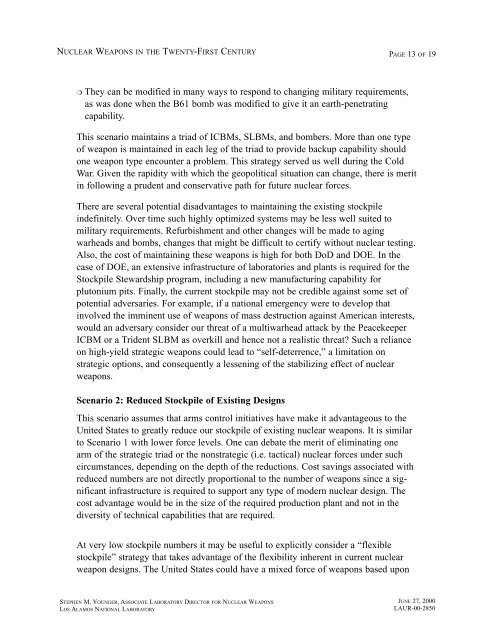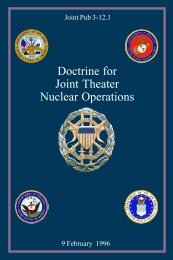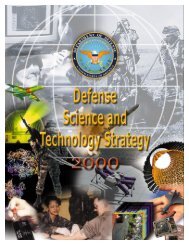Nuclear Weapons in the Twenty-First Century - Sciencemadness.org
Nuclear Weapons in the Twenty-First Century - Sciencemadness.org
Nuclear Weapons in the Twenty-First Century - Sciencemadness.org
Create successful ePaper yourself
Turn your PDF publications into a flip-book with our unique Google optimized e-Paper software.
NUCLEAR WEAPONS IN THE TWENTY-FIRST CENTURY<br />
PAGE 13 OF 19<br />
❍ They can be modified <strong>in</strong> many ways to respond to chang<strong>in</strong>g military requirements,<br />
as was done when <strong>the</strong> B61 bomb was modified to give it an earth-penetrat<strong>in</strong>g<br />
capability.<br />
This scenario ma<strong>in</strong>ta<strong>in</strong>s a triad of ICBMs, SLBMs, and bombers. More than one type<br />
of weapon is ma<strong>in</strong>ta<strong>in</strong>ed <strong>in</strong> each leg of <strong>the</strong> triad to provide backup capability should<br />
one weapon type encounter a problem. This strategy served us well dur<strong>in</strong>g <strong>the</strong> Cold<br />
War. Given <strong>the</strong> rapidity with which <strong>the</strong> geopolitical situation can change, <strong>the</strong>re is merit<br />
<strong>in</strong> follow<strong>in</strong>g a prudent and conservative path for future nuclear forces.<br />
There are several potential disadvantages to ma<strong>in</strong>ta<strong>in</strong><strong>in</strong>g <strong>the</strong> exist<strong>in</strong>g stockpile<br />
<strong>in</strong>def<strong>in</strong>itely. Over time such highly optimized systems may be less well suited to<br />
military requirements. Refurbishment and o<strong>the</strong>r changes will be made to ag<strong>in</strong>g<br />
warheads and bombs, changes that might be difficult to certify without nuclear test<strong>in</strong>g.<br />
Also, <strong>the</strong> cost of ma<strong>in</strong>ta<strong>in</strong><strong>in</strong>g <strong>the</strong>se weapons is high for both DoD and DOE. In <strong>the</strong><br />
case of DOE, an extensive <strong>in</strong>frastructure of laboratories and plants is required for <strong>the</strong><br />
Stockpile Stewardship program, <strong>in</strong>clud<strong>in</strong>g a new manufactur<strong>in</strong>g capability for<br />
plutonium pits. F<strong>in</strong>ally, <strong>the</strong> current stockpile may not be credible aga<strong>in</strong>st some set of<br />
potential adversaries. For example, if a national emergency were to develop that<br />
<strong>in</strong>volved <strong>the</strong> imm<strong>in</strong>ent use of weapons of mass destruction aga<strong>in</strong>st American <strong>in</strong>terests,<br />
would an adversary consider our threat of a multiwarhead attack by <strong>the</strong> Peacekeeper<br />
ICBM or a Trident SLBM as overkill and hence not a realistic threat Such a reliance<br />
on high-yield strategic weapons could lead to “self-deterrence,” a limitation on<br />
strategic options, and consequently a lessen<strong>in</strong>g of <strong>the</strong> stabiliz<strong>in</strong>g effect of nuclear<br />
weapons.<br />
Scenario 2: Reduced Stockpile of Exist<strong>in</strong>g Designs<br />
This scenario assumes that arms control <strong>in</strong>itiatives have make it advantageous to <strong>the</strong><br />
United States to greatly reduce our stockpile of exist<strong>in</strong>g nuclear weapons. It is similar<br />
to Scenario 1 with lower force levels. One can debate <strong>the</strong> merit of elim<strong>in</strong>at<strong>in</strong>g one<br />
arm of <strong>the</strong> strategic triad or <strong>the</strong> nonstrategic (i.e. tactical) nuclear forces under such<br />
circumstances, depend<strong>in</strong>g on <strong>the</strong> depth of <strong>the</strong> reductions. Cost sav<strong>in</strong>gs associated with<br />
reduced numbers are not directly proportional to <strong>the</strong> number of weapons s<strong>in</strong>ce a significant<br />
<strong>in</strong>frastructure is required to support any type of modern nuclear design. The<br />
cost advantage would be <strong>in</strong> <strong>the</strong> size of <strong>the</strong> required production plant and not <strong>in</strong> <strong>the</strong><br />
diversity of technical capabilities that are required.<br />
At very low stockpile numbers it may be useful to explicitly consider a “flexible<br />
stockpile” strategy that takes advantage of <strong>the</strong> flexibility <strong>in</strong>herent <strong>in</strong> current nuclear<br />
weapon designs. The United States could have a mixed force of weapons based upon<br />
STEPHEN M. YOUNGER, ASSOCIATE LABORATORY DIRECTOR FOR NUCLEAR WEAPONS<br />
LOS ALAMOS NATIONAL LABORATORY<br />
JUNE 27, 2000<br />
LAUR-00-2850






